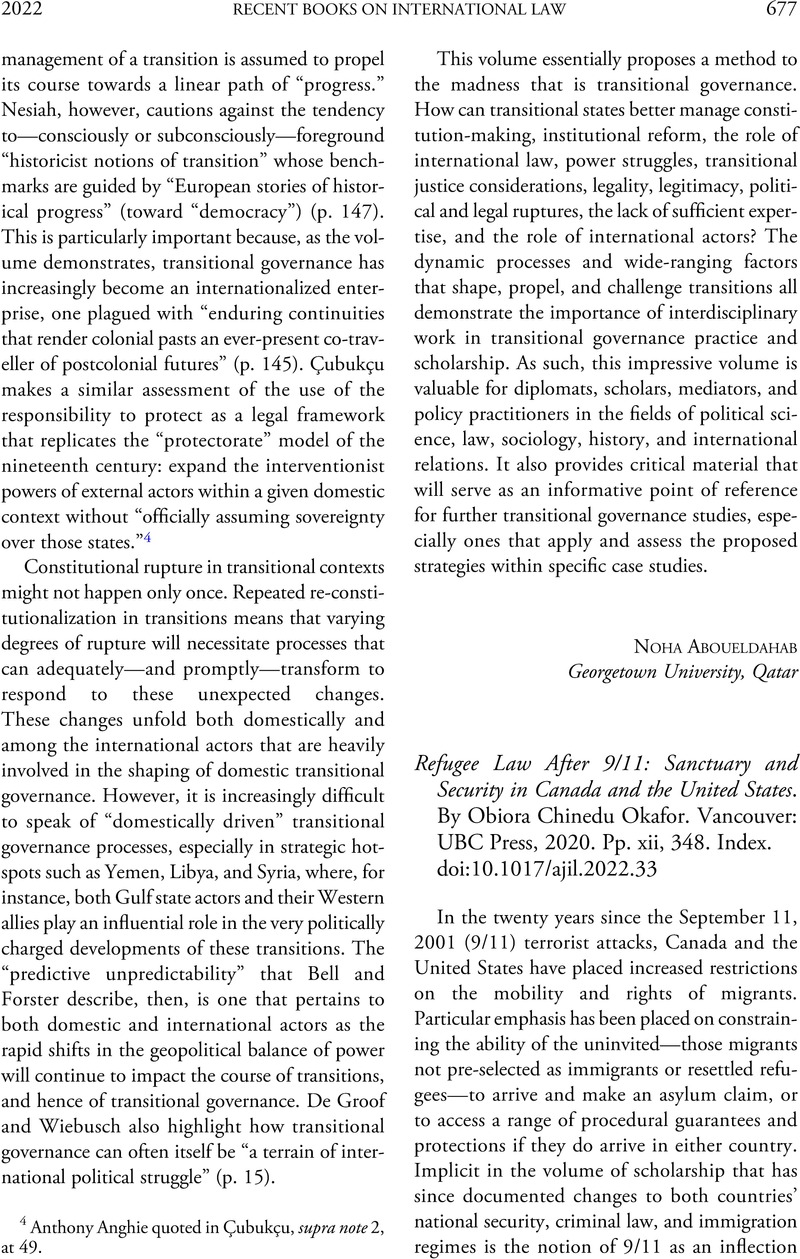No CrossRef data available.
Published online by Cambridge University Press: 28 July 2022

1 Agreement Between the Government of Canada and the Government of the United States of America for Cooperation in the Examination of Refugee Status Claims from Nationals of Third Countries, United States and Canada, Can. TS 2004 No. 2 (Dec. 5, 2002) (entered into force Dec. 29, 2004).
2 Pub. L. No. 104-208, 110 Stat. 3009-546 (1996).
3 Pub. L. No. 104-132, 110 Stat. 1214 (1996).
4 Subject to limited exceptions for “extraordinary circumstances.” See Immigration and Nationality Act (INA), § 208(a)(2)(D), 8 U.S.C. § 1182(2)(a).
5 Immigration and Refugee Protection Act, S.C. 2001, ch. 27 (Can.) (IRPA).
6 Immigration Act, 1976-1977, ch. 52, sec. 1 (Can.).
7 Sarbit, Lara, The Reality Beneath the Rhetoric: Probing the Discourses Surrounding the Safe Third Country Agreement, 18 J. L & Soc. Pol'y 138, 143 (2003)Google Scholar.
8 Describing the government's voluntary removal of provisions mandating the detention of individuals named in a Security Certificate, in spite of the Supreme Court of Canada's ruling that the provisions were constitutional.
9 Stumpf, Juliet, The Crimmigration Crisis: Immigrants, Crime, and Sovereign Power, 56 Am. U. L. Rev. 367, 378–81 (2006)Google Scholar. See also Šalamon, Neža Kogovšek, Frett, Barry & Ketchum, Elizabeth Stark, Global Crimmigration Trends, in Causes and Consequences of Migrant Criminalization 3, 4–5 (Šalamon, Neža Kogovšek ed., 2020)CrossRefGoogle Scholar.
10 Stumpf, supra note 9, at 396–402.
11 See Asad G. Kiyani, Criminalization, Safety and the Safe Third Country Agreement, in Borders and Migration: The Canadian Experience in Comparative Perspective (Michael Carpenter, Melissa Kelly & Oliver Schmidtke eds., forthcoming 2022).
12 Legomsky, Stephen H., The New Path of Immigration Law: Asymmetric Incorporation of Criminal Justice Norms, 64 Wash. & Lee L. Rev. 469, 472 (2007)Google Scholar (“Rather than speak of importation of the criminal justice model, then, a more fitting observation would be that immigration law has been absorbing the theories, methods, perceptions, and priorities of the criminal enforcement model while rejecting the criminal adjudication model in favor of a civil regulatory regime.”).
13 House of Commons Debates. 2012a. 41st Parl., 1st Sess., No. 108, at 7048 (Apr. 23, 2012) (Can.) (Jason Kenney, Minister of Citizenship and Immigration).
14 House of Commons Debates. 2012b. 41st Parl., Bill C- 31 2nd Reading (June 8, 2012) (Can.) (Rick Dykstra, Parliamentary Secretary to the Minister of Citizenship and Immigration).
15 For not instituting an upper limit on how long migrants may be detained. See UN Human Rights Committee, Concluding Observations on the Sixth Periodic Report of Canada – International Covenant on Civil and Political Rights, para. 12, UN Doc. CCPR/C/CAN/CO/6 (Aug. 13, 2015).
16 Immigration and Refugee Board, Report of the 2017/2018 External Audit (Detention Review) (July 2018) (Can.), at https://irb-cisr.gc.ca/en/transparency/reviews-audit-evaluations/Pages/ID-external-audit-1718.aspx.
17 IRPA, supra note 5, sec. 102(1).
18 See also Macklin, Audrey, Citizenship, Non-citizenship and the Rule of Law, 69 U. New Brunswick L.J. 19, 40 (2018)Google Scholar.
19 Canadian Council for Refugees v. Canada (Immigration, Refugees and Citizenship), 2021 FCA 72 (Can.).
20 Sarbit, supra note 7, at 143.
21 This need to reduce numbers in Canada was acknowledged in both the United States and Canada. See Regulatory Impact Analysis Statement: Regulations Amending the Immigration and Refugee Protection Regulations RIAS, Canada Gazette 138, pt. II, no. 22, 1622–24 (Nov. 3, 2004) (noting that the STCA will mitigate “significant pressures” on the asylum system and will lead to “the workload at land border ports of entry . . . [being] significantly reduced”); United States and Canada Safe Third Country Agreement: Hearing Before the Subcommittee on Immigration, Border Security, and Claims of the Committee on the Judiciary, 107th Cong., 45 (Prepared Statement of Bill Frelick) (“Put simply, from the U.S. perspective, there is no problem that this Agreement would remedy (and quite a few problems that it would likely cause). The Canadian government has a more obvious reason for wanting to conclude this agreement. In contrast to the estimated 200 persons per year who apply for asylum in the United States after passing through Canada, an estimated 15,000 refugee claimants per year—about one-third of Canada's annual asylum caseload—arrive via the United States.”).
22 Canadian Council for Refugees, Closing the Front Door on Refugees: Report on the First Year of the Safe Third Country Agreement 27 (2005), 3 (stating that the number of asylum claims made at land border entry points in the first year of the agreement fell by 49%).
23 Citing Macklin, Audrey, Disappearing Refugees: Reflections on the Canada-U.S. Safe Third Country Agreement, 36 Col. Hum. Rts. L. Rev. 365, 414–16 (2005)Google Scholar.
24 See IRPA, supra note 5, sec. 101(1)(c.1).
25 See, e.g., Exec. Order No. 14010, Executive Order on Creating a Comprehensive Regional Framework to Address the Causes of Migration, to Manage Migration Throughout North and Central America, and to Provide Safe and Orderly Processing of Asylum Seekers at the United States Border, 86 F.R. 8267 (Feb. 2, 2021), that, inter alia, revoked or requested various officials to consider which parts of nineteen different executive orders, policies, programs, and laws ought to be retained, and to develop new policies on addressing the root causes of migration; a collaborative migration management strategy; the assessment of asylum claims where persecution is based on domestic or gang violence; and, regulations defining when a person should be considered a member of a particular social group as defined in international refugee law). See also Exec. Order No. 14012, 86 F.R. 8277 (Feb. 2, 2021), ordering a review of, inter alia, certain inadmissibility and deportation grounds.